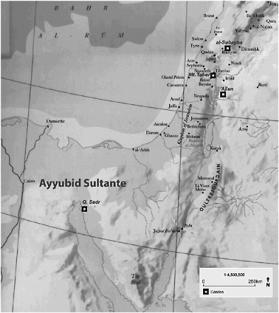Muslim Fortresses in the Levant: Between Crusaders and Mongols (9 page)
Read Muslim Fortresses in the Levant: Between Crusaders and Mongols Online
Authors: Kate Raphael
Tags: #Arts & Photography, #Architecture, #Buildings, #History, #Middle East, #Egypt, #Politics & Social Sciences, #Social Sciences, #Human Geography, #Building Types & Styles, #World, #Medieval, #Humanities

Johns conducted a thorough study of in the late 1920s.
in the late 1920s.
7
His detailed conclusions were partly revised by a French team, headed by Dangles which surveyed the site in 2002.
8
The ranciscan monks Bagatti and Battista published the excavations and survey of the fortress on Mount Tabor.
9
Deschamps surveyed , and was the first to chart and draw a plan of the fortress, still used today by most scholars. This fotress, at first attributed to the Crusaders, was recognized as an Ayyubid construction only in 1989, after Ellenblum and Amitai carefully surveyed the historical sources and the inscriptions.
, and was the first to chart and draw a plan of the fortress, still used today by most scholars. This fotress, at first attributed to the Crusaders, was recognized as an Ayyubid construction only in 1989, after Ellenblum and Amitai carefully surveyed the historical sources and the inscriptions.
10
Hartal thoroughly explored the Ayyubid towers on the western side of in his excavation conducted in the winter of 1993, but did not cover the rest of the site.
in his excavation conducted in the winter of 1993, but did not cover the rest of the site.
11
Barthoux, who published his finds in a short paper, first visited the fortress of in 1909.
in 1909.
12
Wiet translated and analyzed the inscriptions from photographs taken by Barthoux, publishing them in 1922.
13
The site was later visited and surveyed by Tamari while researching the Darb (“Pilgrims’ Road”) in the Sinai Peninsula.
(“Pilgrims’ Road”) in the Sinai Peninsula.
14
In the 1990s Jean-Michel Mouton and surveyed the fortress and published a series of articles.
surveyed the fortress and published a series of articles.
15
The importance of the fortresses varies considerably – while Mount Tabor and represent frontier fortresses,
represent frontier fortresses, is located in a rural area and
is located in a rural area and is on an important pilgrimage route. The fact that the four fotresses were constructed over almost sixty years, allows us to study the gradual changes that occurred throughout this period.
is on an important pilgrimage route. The fact that the four fotresses were constructed over almost sixty years, allows us to study the gradual changes that occurred throughout this period.
As is to be expected, grand urban Ayyubid citadels such as that in Cairo and major cities in central Syria have been thoroughly studied.
16
Several monographs have been published on individual Ayyubid fortresses, and yet there is no comprehensive work examining the subject.
Creswell was the first to research Muslim fortifications built prior to 1250.
17
In his book on
Crusader Castles
, Kennedy devotes a short chapter to Muslim castles of the twelfth and thirteenth centuries, touching briefly on the subject of Ayyubid fortresses.
18
The two volumes by Korn on Ayyubid architecture in Syria and Egypt do not deal explicitly with fortifications but decidedly contribute to the general subject.
19
Hillenbrand includes a lengthy chapter on Muslim fortifications, in her book
The Crusades: Islamic Perspective
, which contains valuable information and

Map 1.1
Ayyubid fortresses in the twelfth and thirteenth centuries (after Kennedy,
Historical Atlas of Islam
, 22–3)
gives a swift survey of the most important sites.
20
Her views, however, cannot be accepted without reservations. First, it is necessary to differentiate between Ayyubid and Mamluk fortifications and not to treat the two periods as one. The geopolitical and the military situation in the Levant had changed considerably; the centralization of the Mamluk sultanate and the composition of the army are clearly reflected in both the spatial distribution of Mamluk fortresses and the scale of their architecture. Second, Hillenbrand’s statement that “almost all Crusader castles were built to withstand siege; Muslim castles were not,”
21
is rather surprising. Crusader and Mongol armies besieged Ayyubid fortresses, as did rivals within the Ayyubid
sultanate who laid siege to one another’s cities and fortresses. While some fortresses managed to resist assaults, others failed. Early Mamluk strongholds stood fast against the Mongol-Īlkhānid armys. Siege warfare was decidedly a matter carefully dealt with and an integral part of Ayyubid and Mamluk fortresses.
